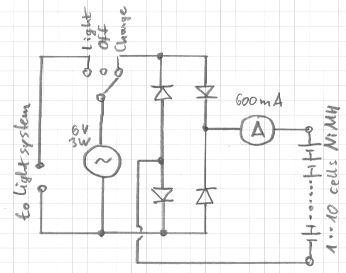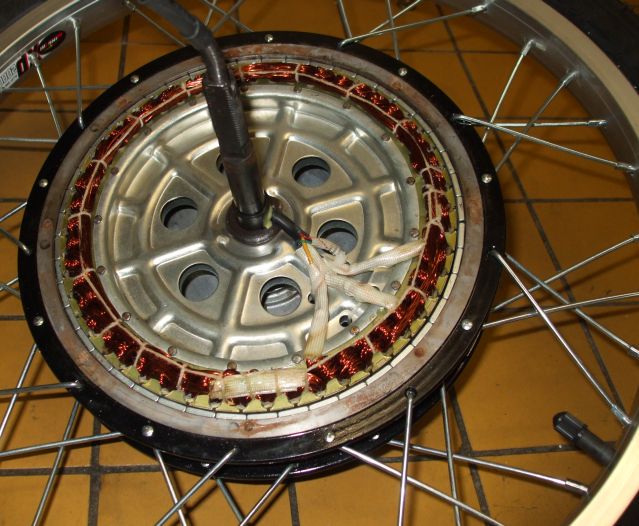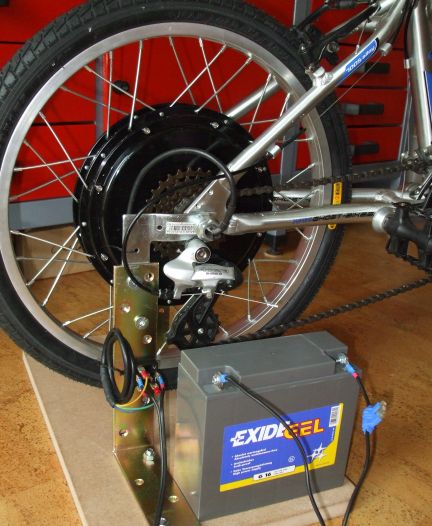Why pedaling for electricity ?
Know the cost of one KWh as your electricity company sells it ? It's EUR
0.23 in my place and earning this through pedal power would take me 10
hours. Not much of an incentive to think about pedal generators. Still
the need for pedal power generation seems to exist, as frequent e-mail
requests tell me. Well, pedal power can be made available anywhere, it
requires no fuel, is available both day and night, the equipment is
inexpensive and needs almost no maintenance.
This page addresses two key use cases:
- Charging batteries for small, portable devices while traveling on a bicycle
- Generating as much electrical power as possible on a stationary pedal generator
Low power battery charging

This project fits a travel bike that will be taken to remote locations
with no electricity. The user will be able to charge NiMH batteries for
light, communication, navigation and entertainment equipment, utilizing
the energy from the bike's standard 6V/3W dynamo. While riding, up to 6W
of electrical power are available to the charger (not a mistake, it is
about twice the rated dynamo power).
A switch selects either the light system,
the battery charge mode or OFF. In charge mode, the rectified dynamo
current is driven through a string of series-connected NiMH cells. At
moderate riding speed, one to 10 cells can be charged at once. The
current is typically 500mA and decreases somewhat as cell count
increases. The ammeter displays the charge current, so it's easy to see
if cells charge correctly and at the expected current.
All 4 diodes are 1N5402 (or 1N5404 through 1N5408). Alternatively, use
1N4003 through 1N4007 (lower current capability, higher chance of damage
if reversing battery polarity).
If individual cells will be charged, an appropriate battery box is
needed. A jumper cable makes the box adapt to fewer cells. It's
acceptable to mix different types of cells; they will all be charged at
the same current.
The circuit withstands operation without batteries connected. Batteries
may remain attached to the circuit permanently, none of the modes
produces a leakage current that discharges the cells. One weak point of
the circuit is wrong battery polarity: This could fry the diodes and the
ammeter. If batteries are likely to be reversed, a fuse should be added
in line with the ammeter.
There is no end-of-charge indication as this would be unreliable with
the fluctuating supply of a dynamo. Not a problem, cells get time to
relax and cool down as the bike stops from time to time. With the rider
being right there with his sense of time and his temperature probe
finger, it's highly unlikely that batteries get forgotten and "cooked"
for many hours. Much unlike cheap mains-powered chargers that overcharge
NiMH cells by design - and still the cells last quite a while.
Stationary pedal generator / high power battery charging

This project is capable of providing basic electricity to a remote
location where solar panels are not practicable. While pedaling, up to
300W are available (40 ..150 continuously, depending on rider).
The Internet holds a lot of suggestions on how to build a pedal-powered
electrical generator. Now what has put ME off is that all these
solutions require odd parts that are hard to come by and / or demand a
lot of mechanical work in adapting a motor / generator to a bicycle. The
end product often suffers from friction, belt slip and rapid wear.
With the popularity of electric bicycles on the rise, the pedal
generator builder's life has become easier: Today we have a good variety
of bicycle hub motors, many of these made in Chinese factories and
often being sold for less than EUR 100. These motors carry magnets on
the rotor while the copper windings are on the stationary part. They are
perfect dynamos !
Selecting the right motor
- The motor will be driven on a stationary bike, so has to be a rear
hub motor (front wheel of stationary bike obviously not being driven) - For good efficiency, the motor should employ state-of-the-art rare-earth permanent magnets and it should be brushless
- To achieve the best flywheel effect, the motor should be heavy and put in a wheel
- To minimize mechanical losses, the motor should be direct drive / not use internal gears
- To cope with the power of a physically-fit pedaler for longer
periods of time, the motor should be rated for at least 200W, more is
better (reduces losses, increases weight) - The voltage of the motor should exceed the desired output voltage,
so that there's useful output even when not pedaled full-steam
The picture shows the guts of the motor that I've picked. It's a 24V,
500W rear hub motor made by Golden Motor / Jiangsu and it will charge a
12V battery for me.

The mechanical setup
- Find a bicycle to use - it can be any piece of junk but it needs a
working BB, pedals, chain, a saddle and ideally a rear derailleur - Replace the rear wheel with the hub motor
- Put the bike on a stand so that the rear wheel can spin freely (some
older Durch or Chinese pannier racks incorporate a stand that will work
nicely). Alternatively suspend the tail of the bike so that it just
doesn't touch the ground.
I myself have built a stand from metal brackets mounted on a wooden base.
Restoring the bike to its original condition is fast: Remove from stand and swap the wheel back.
The electrical circuit
Input is the motor / generator on the left of the schematic, output
( 12V-) is on the very right. Any load could be connected to the output:
Light bulbs, fluorescent ballast, LED lighting fixtures, radio, cell
phone charger, TV